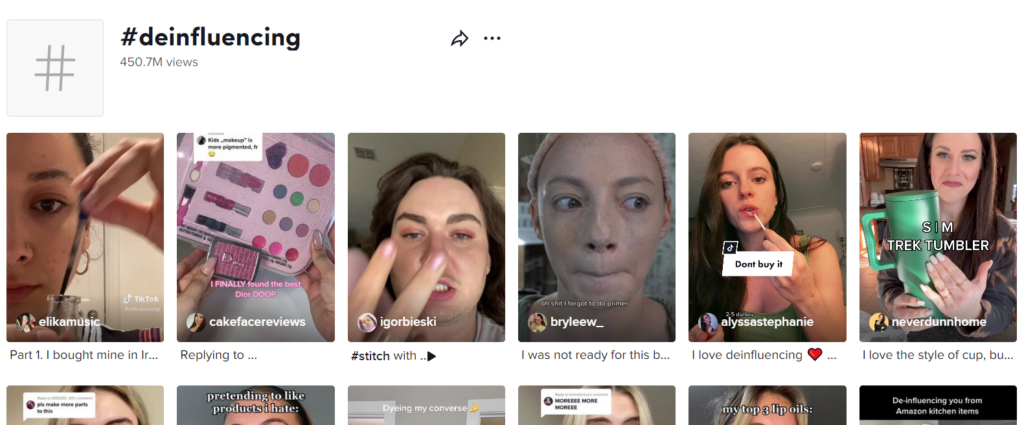Deinfluencing is more than just a hashtag, it’s a response to the expensive influencer marketing campaigns pushing products on consumers.
Since this trend has been gaining steam in 2023, it might be time for you to check it out for yourself and see if deinfluencing has a place in your content strategy.
What Is DeInfluencing?

Deinfluencing is all about helping break the hype around products that are widely recommended for no good reason. It’s content about what not to buy, usually targeting products that are recommended by a lot of other influencers. These are usually products that are overpriced, unnecessary or both.
The movement isn’t entirely new. It’s been happening on and off in different industries for a while now, especially when any single product starts getting too much attention from influencer marketing and content sponsorships. The biggest difference is that the trend now has a name, “deinfluencing”.
Most creators who make deinfluencing content discuss a product that’s over-hyped and why you shouldn’t buy it. They can then go on to talk about better options or alternatives that don’t involve buying anything. The main point is to break through all the content pushing people to buy a specific product and giving an alternative perspective on it.
Deinfluencing is such a popular trend because people are sick of manipulative content recommending products that the content creators themselves don’t even use regularly. Deinfluencing leads to honest content that gives the viewer a more realistic idea of what they can expect from a product, which is what makes it so powerful.
If you want to be part of the trend yourself, here are a few things you can do to jump in!
Start Talking about Products
As obvious as it sounds, you have to be able to talk about products to do deinfluencing content. You don’t have to recommend products and do affiliate marketing, but there is an aspect of talking about specific products that’s necessary for good deinfluencing content.
You can start by talking about products you know of that you see recommended a lot. If you can get your hands on it, test the product for yourself and give honest feedback about its usefulness or lack thereof.
Even if you can’t get the product for yourself, you can still talk about it and give an opinion about why it might not be a good choice, as long as you have some kind of experience in your niche that gives you the authority to talk about it.
The way you talk about products matters. Make sure you’re being genuine in what you’re saying, giving your viewers an honest review, whether it’s good or bad.
Make People-Centered Recommendations

Instead of thinking about products from a monetization standpoint, look at them from a buyer’s perspective. Look at products that will provide the most value to your viewers, rather than yourself.
To help you make better people-focused recommendations, think about if and how you’d actually use a product in your own life. Whether you’re talking about makeup kits, gardening tools, car detailing kits, or anything else, you need to think of the value it could provide to you or others engaging with your content.
If you want to make a bigger impact with your product recommendations, think about unique ways a product could be useful to people with specific needs. For example, think about how some products might be able to help people with disabilities or how others could help beginners to learn a skill more easily.
These kinds of people-centric recommendations are good for your audience, especially since they can help people see the true value of some products they might otherwise have dismissed. It also builds your credibility when you can make good recommendations to your audience about things they might actually be able to use.
Be Nuanced, Not One-Size-Fits-All
Part of speaking about products in a useful way is to acknowledge that no product is perfect for everyone. One issue people have with influencers is the way products are broadly marketed to all, even though they might not make sense for every circumstance.
Deinfluencing involves showing why some of these products aren’t a good recommendation for everyone and who they might be useful for. Sometimes products that are widely recommended do have some legitimate uses, they’re just not meant for everyone. If you can help your audience discern which products are a good fit for them and which they should pass on, you’ll build trust with your audience.
Make sure you talk about all products with a nuanced perspective, letting your audience know what each product is best for and if it’s good at what it’s supposed to do.
Talk About Product Alternatives

A big part of deinfluencing is showing how other, cheaper products can do the same job as over-hyped products. Common, affordable products can often be way better than some influencer-recommended products. Shedding some light onto these affordable alternatives is a good way to help your audience make better buying decisions for themselves.
Making content about alternative products also gives you a good opportunity to educate your audience about why a certain product works the way it does or why a different product is better. Educational content can help your audience become more informed buyers in the future, a valuable skill that they’ll remember you for.
You don’t have to talk about all products as either useful or not. Sometimes the best alternative to a new product is not using one at all!
There are a lot of products that are completely unnecessary because the things they do can easily be done without them. If you’re not interested in recommending products to your audience, show them some of the alternative ways to do things without any specialty products.
This type of educational content can be a great fit for niches that involve a skill since it allows you to teach your audience something valuable. It also works as a chance to show your expertise and gain some authority in your niche, helping you stand out in a crowded content feed.
Be Consistent
The whole point of deinfluencing is to be authentic. If you’re going to talk about products, you need to make sure you have a consistent way of judging and valuing those products. This is how you separate yourself from other creators who allow affiliate sales, commissions, or sponsorships to soften their standards.
Make sure that every time you talk about products you can answer these questions:
- Why is this product valuable?
- Is there a better solution?
- Does the product do what it’s supposed to?
- Is it good value for money?
- Would you use it yourself?
Be discerning about what you recommend to your followers. Don’t just pick products at random or go along with what everyone else is recommending. If you don’t have a personal opinion about a product, you’ve never seen or used it yourself, or you wouldn’t use that product for yourself, those might be signs you shouldn’t recommend that product.
Set standards of what you consider to be characteristics of a good product in your niche, then stick to those standards as long as they make sense. Use those standards as criteria to judge anything you want to tell your followers about.
What do you think of the deinfluencing movement? Let us know in the comments below!


